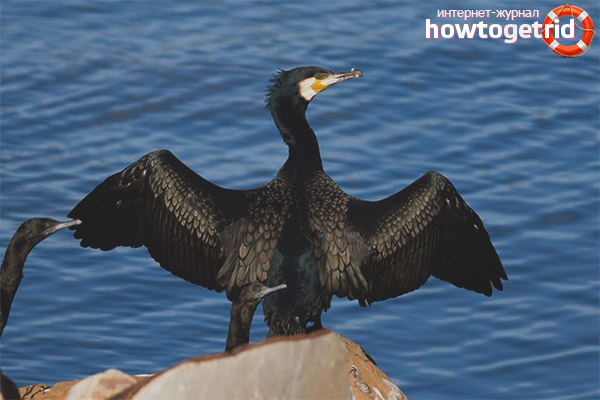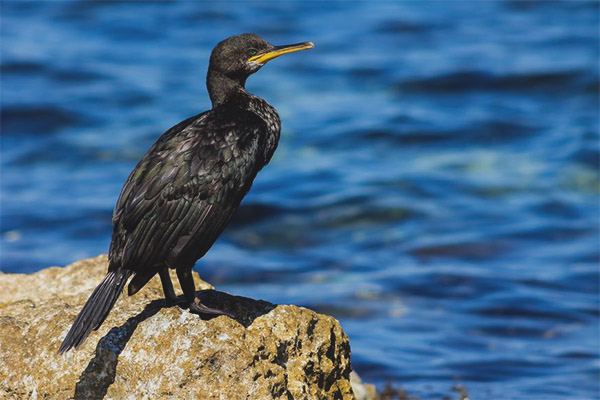The content of the article
A detachment of pelican-like has many species that differ significantly from each other. One of the most popular was the great cormorant. Quite a large bird in size and body lines resembles a duck. It is considered a professional fisherman among waterfowl. It cannot be otherwise, since the bird has a good appetite and eats about 500 grams per day. fish. It is interesting to observe the process of fishing and nesting cormorant.
Appearance and habits
Every creature of nature is perfectly and most adapted to its environment. The appearance of the cormorant fully confirms this thought.
The main diet of the bird consists of fish. Fishing requires excellent response, patience and endurance. The size of birds ranges from 50 to 100 cm, females are slightly smaller than males. In the coloring of adults, a dark, almost black color with a greenish or purple shine prevails.The head is decorated with a short black tuft. During the period of grooming, the males appear white thin feathers on the sides of the head, more like weightless hairs. Such a noble gray hair gives the bird a remarkably respectable look. At first, young people wear brown outfit with bright spots on the stomach and neck, acquiring adult coloring only by the age of 4.
The grayish beak is arranged like a fishing hook, only the grooves are inside, on the surface of the palate and prevent the fish from slipping out.
Strong paws with membranes are perfectly adapted for fast swimming and maneuverable movement under water, but on land they fail to master, provoking an unstable position and a funny swinging gait.
The structure of the beak hides a special secret. Due to the large mobility of the ligaments, it opens up very widely, and the cormorant easily swallows even large fish. The throat sac is small and does not play a special role in the process of feeding an adult bird.
The cormorant spends most of its time in the water, only the head and a thin strip of the back are visible on the surface. Dives into the depths like a submarine, quietly, smoothly and without a surge.Usually they need 1 - 2 minutes to catch a tasty fish at a depth of 3 - 4 meters. Sometimes the hunting excitement leads them to 8 - 10 meters.
The menu is quite diverse:
- sardine;
- anchovy;
- capelin;
- herring;
- shellfish;
- crayfish;
- frogs;
- turtles;
- snakes.
Good appetite does not allow to pick and choose for a long time. The Great Cormorant eats everything that it catches, and in the art of fishing it has almost no equal. The cormorants fly reluctantly, they need a run to climb.
For nesting, couples choose any body of water; they can build a nest on rocks near the seashore. They are not confused by the presence of other species of birds, often there are colonies where cormorants, herons, gulls and terns get along peacefully.
Parents care a lot. First, they build a nest of branches, leaves, algae, sealed with droppings, on tree tops or rocky eaves. Then lay eggs with an interval of several days, their number is 5 - 6 pieces. Nestlings demand vigilant care, being born naked and blind. They need to be warmed, fed, protected from lovers to feast on someone else's nest. Only in 2 weeks the chicks will have thick warm down. Feeding chicks is the concern of both parents.The basis of nutrition in the first month and a half is semi-digested fish. Later, older children will be able to swallow it whole. At this time they have a thirst for adventure. They often leave the nest and roam the earth, moving along the branches of the native tree. Gray ravens and large seagulls pose the greatest threat to them at this time.
Peculiarities of the life of great cormorants

There is a stereotype that waterfowl do not get wet. Cormorants do not know about this and are forced to spend much of their time on the plumage after each fishing. Often, on the coast, curious birds sit, exposing their wings and tail to the sun and wind.
Birds with white plumage are sometimes born among individuals. This miracle of nature is even rarer than the white crow.
Cormorants and pelicans often organize joint fishing. Pelicans scare fish with loud flapping of wings and drive a shoal into shallow water, and cormorants do not let it go back until all the participants in the hunt have lunch.
In ancient times, birds were tamed and used for fishing. The rig included a ring and a long rope. The ring was worn on the neck and the cormorant could not swallow the prey, and with the help of the rope it was returned back. Now a similar way of fishing is shown only to tourists.
In nature, there are 6 species of cormorants living in freshwater bodies and on the sea coast. Among them, two species are listed in the Red Book.
Video: Great Cormorant (Phalacrocorax carbo)











To send